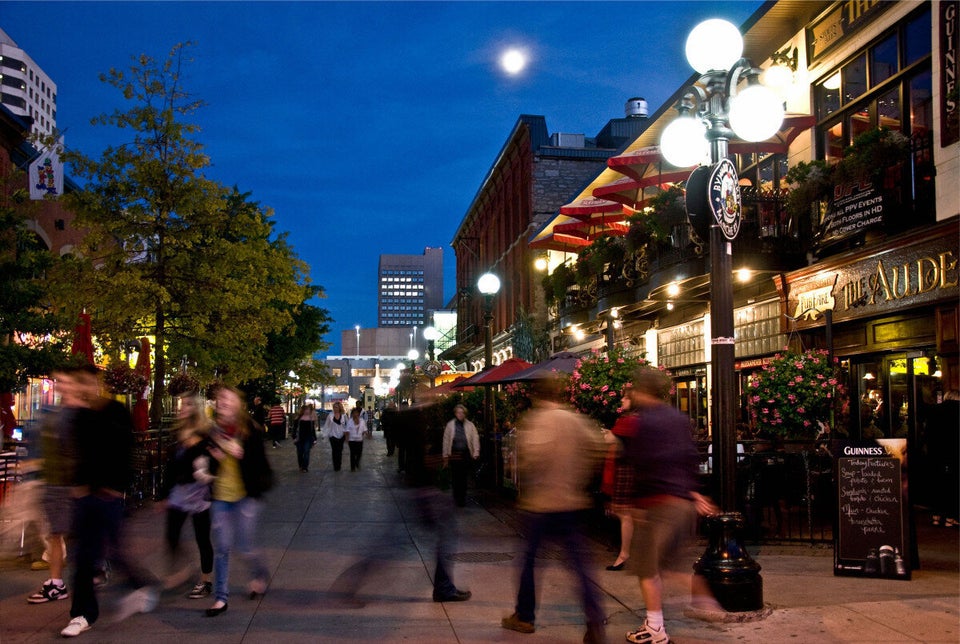
As a small city -- some would say even a large town -- Fredericton offers unique advantages of shorter commutes, close proximity to nature and the countryside, relatively low housing costs, and a historic downtown that gives a unique charm to the city.
At the same time as having a small town ambience, Fredericton offers "big city" advantages such as two universities, a community college, an arts college, art galleries, as well as being the province's centre of government. In addition to all this, Fredericton has an emerging high-tech sector (even if set back with the recent Radian6 layoffs).
Good urban planning is important to preserving Fredericton's quality of life advantages -- including its "unique charm and character" as identified in the city's 2007 municipal plan -- that make it a desirable place to live and work. This includes promoting walkable streets, unique architecture that enhances the character of the city, and curbing generic box-store style sprawl.
This 2007 municipal plan emphasizes the importance of promoting a knowledge-based economy (high-tech, research and development) with the suburban-style Knowledge Park playing a key role in this regard. However, in recent years, downtown-like environments -- the "fixer-upper" loft rather than the gleaming suburban office-park building -- have become increasingly popular sites for high-tech start-ups.
Richard Florida, an urban affairs academic and writer, noted this trend in an article he wrote for the Wall Street Journal, writing that while the largely suburban Silicon Valley was still "the world's pre-eminent centre of high-tech industry," even in this region, neighbourhoods like downtown Palo Alto with mixed-use buildings and richer street-life were becoming a more popular location for start-ups and that high-profile start-ups such as Pinterest and Yelp were setting up in downtown San Francisco.
The article quoted Twitter co-founder Jack Dorsey stating that "I love the idea of an urban corporate campus with all the energy and variety that provides." Florida's article further stated that younger people (as well as many in the high-tech sector overall) are increasingly preferring downtown-style locations for walkability and social activities (in his latest book Florida also cited rich street-life as important in this regard).
BLOG CONTINES AFTER SLIDESHOW
So how does this apply to Fredericton?
Walkable and mixed-use neighbourhoods are key to promoting economic development in the city -- including a rich arts and culture scene that would be an attraction to young professionals and entrepreneurs. Fredericton can offer the amenities of a larger city -- universities, arts culture, and government amenities -- without the congestion or high housing costs of larger cities, something that would be attractive to many seeking an alternative to larger centres such as Toronto.
Fredericton's municipal plan identifies Main Street -- a northside thoroughfare that runs roughly parallel to the Saint John River which divides Fredericton's north and south side -- as the northside's "busiest commercial area" and as a place that is a priority for "streetscape improvements" including "infilling" and "redevelopment" to make it "an attractive and functional centre of commercial activity." Union Street, which continues west from Main Street, is identified for similar streetscape and aesthetic improvements.
Main and Union Street are already a sort of proto-downtown -- with older buildings mixed in with strip malls with vast parking-lot frontage. There is, in this area, older building stock that can serve as the kind of "lofts" and "fixer-uppers" conducive to start-ups if there is a streetscape conducive to walkability -- with a street-frontage of shops, restaurants, and other amenities, as well as downtown-style mixed-use buildings (i.e. stores on the first floor and residences above) as density alone is not enough. As well, items such as more street crossings to make the area pedestrian-friendly would help in this regard.
Being across the river from downtown Fredericton, this area could serve as an extension of Fredericton's existing downtown -- to enhance the cultural, artistic, and economic life of the city. The possibility of a Carleton Street walking bridge -- discussed in the municipal plan -- could enhance the link between downtown Fredericton and these northside neighbourhoods. This overall would be consistent with Mayor Brad Woodside's vision of thinking beyond northside and southside, and conceiving of Fredericton as one city overall.
In Fredericton's existing southside downtown, there is room for initiatives such as opening up Queen Street to car-free status on occasions outside the Harvest Jazz and Blues Festival (such as introducing new festivals or having car-free weekends in the summer). This would offer new venues for artists and street-performers, further enhancing the city's creative economy and potential for tourism. In Burlington, Vermont -- a smaller city like Fredericton -- Church Street, which is permanently pedestrian only, has become a popular focal point of that city's downtown, a hub for artists and street-performers, a draw for tourists, and a boost for local businesses.
There are potential improvements in other areas of Fredericton as well. In other commercial areas of the city, in particular those that are in close proximity to residential neighbourhoods, such as the northside's Brookside Mall and the southside's Uptown Centre (a mall turned box-store development) and the Canadian Tire Plaza, simple improvements on the property, such as tree-lined walkways so that pedestrians are not forced to dodge cars in the parking lot and aesthetically pleasing facades, could make these areas function better as neighbourhood centres and improve walkability.
Fredericton offers the advantages of being a small city -- or large town depending on how one sees it -- with big city amenities offered by being a centre of government, education, and high-tech. It is important that municipal planning strategies seek to enhance Fredericton's advantages -- promoting walkability and unique architecture -- curbing generic box-store style sprawl, enhancing what makes Fredericton a great place to live while fostering an environment conducive to a rich creative economy.
